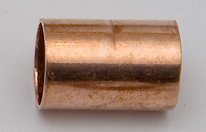Engineering:Coupling (piping)
In piping and plumbing, a coupling (or coupler) is a very short length of pipe or tube, with a socket at one or both ends that allows two pipes or tubes to be joined, welded (steel), brazed or soldered (copper, brass etc.) together.
Alternatively, it is a short length of pipe with two female National pipe threads (NPT) (in North American terms, a coupler is a double female while a nipple is a double male) or two male or female British standard pipe threads.
If the two ends of a coupling are of different standards or joining methods, the coupling is called an adapter.[1] Examples of adapters include one end BSP threaded with the other NPT threaded, and one end threaded with the other a plain socket for brazing.
A coupling whose ends use the same connection method but are of different sizes is called a reducing coupling or reducer. An example is a 3/4" NPT to 1/2" NPT coupling.[2]
See also
- Closet flange
- Eccentric reducer
- Nipple (plumbing)
- Piping and plumbing fittings
- Reducer
- Street elbow
References
Further reading
- ASME B1.20.7 Hose Coupling Screw Threads, Inch. (Quote: The normal sequence of connections, in relation to the direction of flow, is from an externally threaded nipple into an internally threaded coupling)
External resources
 |


